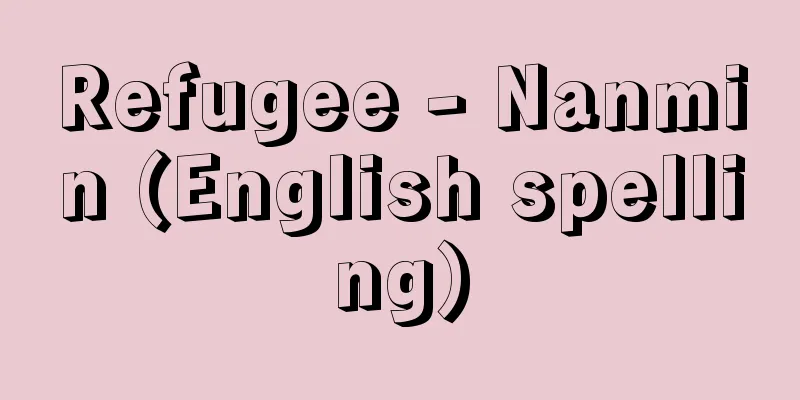Refugee - Nanmin (English spelling)

|
A refugee is someone who has fled to a foreign country to avoid persecution due to differences in race, religion, or political opinion. Recently, most refugees have fled for political reasons, and those who have fled for racial or ideological reasons are often linked to political reasons. These are called political refugees or refugees in the narrow sense, and because they are protected by the Refugee Convention described below, they are also called Convention refugees. They may be called asylum seekers, focusing on their individual status, but the term refugee is used when a certain number of people gather together, and large numbers of refugees arise as a result of war or unrest. In a broader sense, refugees include those who flee their homeland due to natural disasters or famine (economic refugees, displaced persons), and those who remain in their own country (internally displaced persons), and may receive humanitarian protection. [Shigeki Miyazaki] Refugee casesIn the past, there were Puritans who emigrated to the New World after being persecuted by the Stuart dynasty in England, and many royals and aristocrats who fled to foreign countries during the French Revolution. The French word émigré (exile) in the narrow sense refers to the latter. The Russian Revolution of 1917 at the end of World War I also created a large number of Russian refugees, and in order to rescue them, the League of Nations appointed Norwegian Arctic explorer Nansen as the refugee relief commissioner in 1921 after the war, and later also assigned him the task of rescuing Armenian refugees, and about 1.5 million Russian refugees were able to live in about 20 countries. Refugees were given identity cards (Nansen passports) in place of passports. Many refugees were created due to Nazi persecution after 1933, and a German High Commissioner for Refugees was established in 1938, which was merged with the former to form the League of Nations Unified High Commissioner for Refugees in 1939, and an estimated 2.25 million refugees were protected through these efforts. Many refugees were created during World War II, and after the war relief efforts were undertaken by the Intergovernmental Committee for Refugees and the Allied Relief and Rehabilitation Agency. In 1946, the decision was made to establish the International Refugee Organization (IRO) as a specialized agency of the United Nations, which was launched on August 20, 1948. However, in 1952 the organization was abolished and its work was taken over by the United Nations High Commissioner for Refugees (UNHCR). Sadako Ogata served as High Commissioner from 1991 to 2000. [Shigeki Miyazaki] Refugee Convention and ProtocolEven after the Second World War, the Palestine War that began with Israel's independence in 1948 created many refugees, which became a cause of instability in the Middle East. In order to provide relief to these refugees, the United Nations Relief and Relief Agency for Palestine Refugees was established in 1954. The 1948 Universal Declaration of Human Rights stipulated the right to seek and enjoy asylum in other countries from persecution (Article 14), and the 1967 Declaration on the Right to Asylum reaffirmed this right. During this time, the Convention relating to the Status of Refugees was adopted on July 28, 1951, and came into force in 1954. In 1967, the Protocol relating to the Status of Refugees, which expanded the scope of protection, was adopted and came into force the same year. The Convention stipulates the prohibition of the return of refugees to countries where they are at risk of persecution (the principle of non-refoulement), the prohibition of punishment for entering the country as a refugee, the provision of facilities for voluntary return, relocation, and settlement, and humane treatment during their stay. Japan began to take a particular interest in the refugee issue after the Indochinese refugees who fled the country as boat people from Vietnam, Laos and Cambodia after the fall of Saigon in 1975. The government expanded its quota for permanent residence to a maximum of 10,000 people and joined the Convention and Protocol Relating to the Status of Refugees in 1981, which came into effect for Japan on January 1st of the following year, revising the existing Immigration Control Order to become the Immigration Control and Refugee Recognition Act, which came into effect on the same day. However, as the number of Indochinese refugees decreased, the government decided to end the special treatment and treat them the same as ordinary refugees in March 1994. [Shigeki Miyazaki] UNHCR activitiesArmed conflicts, political instability, earthquakes, famines, and other factors caused large-scale refugee movements and humanitarian crises in Bosnia, Iraq, Liberia, Rwanda, the Democratic Republic of the Congo (formerly Zaire), and Somalia, and UNHCR expanded the scope of its protection to include internally displaced persons (IDPs) in addition to refugees in the narrow sense. The number of IDPs increased significantly to 17 million in 1991, 23 million in 1993, and over 27 million in 1995, and then to 22.73 million in 1997 and 21.15 million in 1999 (as of January of each year). UNHCR also provided protection and assistance to approximately 800,000 refugees and IDPs who returned from the Kosovo conflict in March-June 1999. Traditionally, refugee countermeasures have been "reactive," "asylum-centered," and "refugee-oriented," and have sought to find a place for refugees to settle, whether that be through repatriation to their home country, resettlement in the asylum country, or resettlement in a third country. However, a new approach has been adopted that places emphasis on detecting and preventing the emergence of refugees, and to this end, UNHCR has begun to operate in countries that produce refugees or have the potential to do so. [Shigeki Miyazaki] "World Refugee Report 1995: Seeking a Solution," edited by the Office of the United Nations High Commissioner for Refugees (1996, Yomiuri Shimbun) [References] | | | | |Source: Shogakukan Encyclopedia Nipponica About Encyclopedia Nipponica Information | Legend |
|
人種、宗教、政治的意見の相違などによる迫害を避けるために外国に逃れた者を難民とよぶ。最近では政治的理由によるものがほとんどで、人種的、思想的理由によるものも政治的理由と結び付くことが多い。これらを政治難民、狭義の難民とよび、後述する難民条約による保護を受けるので、条約難民ともよぶ。個々の立場に着目して亡命者とよぶこともあるが、ある程度の数がまとまった場合に難民の語が用いられ、戦争や動乱に伴って多数の難民が生ずる。広義では、自然災害や飢饉(ききん)のため居住地外に逃れる者(経済難民、流民)、自国内にいる場合(国内避難民)も難民とよばれ、人道的保護を受ける場合もある。 [宮崎繁樹] 難民の事例古くは、イギリスのスチュアート王朝の迫害を受けて新大陸に移住した清教徒や、フランス革命の際多くの王侯貴族が外国に逃れた例がある。フランス語のエミグレ(亡命者)は、狭義では後者をさす。第一次世界大戦末期1917年のロシア革命によっても大量のロシア難民が生じ、その救済のために、戦後、国際連盟は1921年ノルウェーの北極探検家ナンセンを難民救済の弁務官に任命し、のちにアルメニア難民救済の任務も課し、約150万人のロシア難民が約20か国で生活可能となった。難民に対しては旅券にかわる身分証明書(ナンセン旅券)が付与された。1933年以後ナチスの迫害により多くの難民が生じ、1938年にドイツ難民高等弁務官が置かれ、1939年前者と統合し国際連盟統一難民高等弁務官が置かれ、これらによって推計約225万人の難民が保護された。第二次世界大戦中も多くの難民が生じ、戦後その救済は、政府間難民委員会や連合国救済復興機関によって行われ、1946年国際連合の専門機関として国際難民機関(IRO)の設置が決められ、1948年8月20日発足した。しかし1952年同機関は廃止され、事業は国連難民高等弁務官事務所(UNHCR)に引き継がれた。1991~2000年、緒方貞子(おがたさだこ)が高等弁務官を務めた。 [宮崎繁樹] 難民条約・議定書第二次世界大戦後も、1948年のイスラエル独立から始まったパレスチナ戦争により多くの難民が生じ、中東不安の原因となった。その救済のため、1954年国連パレスチナ難民救済機関が設置された。1948年の「世界人権宣言」は、迫害からの庇護(ひご)を他国に求め享有する権利(第14条)を定め、1967年の「庇護権に関する宣言」はこれを再確認した。この間1951年7月28日「難民の地位に関する条約」が採択され、1954年発効したが、1967年にはその保護対象を拡大した「難民の地位に関する議定書」が採択され、同年発効した。同条約は、迫害のおそれのある国への難民の送還の禁止(ノン・ルフールマンの原則)、難民として入国したことによる処罰の禁止、任意帰国・再移住・定住に対する便宜供与、滞在にあたっての人道的処遇などを定めている。 日本で難民問題にとくに関心がもたれるようになったのは、1975年サイゴン陥落以来ベトナム、ラオス、カンボジアからボートピープルなどとして流出したインドシナ難民を契機とする。政府はその定住受入れ枠を最大1万人まで拡大するとともに1981年「難民の地位に関する条約・議定書」に加入、翌年1月1日日本についても発効させ、従来の「出入国管理令」を改定して「出入国管理及び難民認定法」とし、同日から施行した。しかし、インドシナ難民の減少に伴い、1994年3月には特別待遇をやめ一般の難民と同様に扱うことにした。 [宮崎繁樹] UNHCRの活動世界的にみると各地での武力紛争、政情不安、地震、飢饉(ききん)などによって、ボスニア、イラク、リベリア、ルワンダ、コンゴ民主共和国(旧ザイール)、ソマリアなどで大規模な難民の移動や人道上の危機が生じ、UNHCRは狭義の難民のみならず国内避難民にも保護の対象を広げた。その数は、1991年に1700万人、1993年に2300万人、1995年に2700万人以上と大幅に増加し、その後は1997年に2273万人、1999年に2115万人となっている(各年1月現在)。また、UNHCRは1999年3~6月のコソボ紛争で生じた難民約80万人、および国内避難民の帰還においても保護・援助を行った。従来難民対策としては、本国帰還、庇護国定住、第三国定住など難民の落着き先を探す「事後対応」「庇護国中心」「難民重視」策であったが、難民発生の兆候を未然に察知し、予防する方策に重点を置く新たな取組みを指向し、そのために、難民を生み出す、もしくはその可能性のある国においてもUNHCRは活動を展開することになった。 [宮崎繁樹] 『国際連合難民高等弁務官事務所編『世界難民白書1995――解決をもとめて』(1996・読売新聞社)』 [参照項目] | | | | |出典 小学館 日本大百科全書(ニッポニカ)日本大百科全書(ニッポニカ)について 情報 | 凡例 |
>>: Nanming (English spelling)
Recommend
Education conscription
The former army conscripted replacement soldiers f...
Ido
Also called the id. A key concept in psychoanalyti...
Saint John
A port city in the southern part of New Brunswick,...
Agronomy - English
Agricultural science refers to a unified system o...
Kai (History) - Kai
...However, after the Nanboku-cho period, the dif...
Masako Okumura
...Blind. After becoming a disciple of Asai Chizu...
King Ideok
525-599 * The 27th king of Baekje (Korea). Reigne...
Wakasa Sotomo
Also written as "sotomo" (outer surface)...
《The Mysterious Professor Mabuse》
...In the chaotic and decadent society of Germany...
Louvain-la-Neuve (English spelling)
In the 20th century, the university was in the mi...
Tachibana Zuicho - Tachibana Zuicho
A Shinshu Buddhist monk and explorer. He participa...
Natsufuji (summer wisteria) - Millettia japonica
A creeping deciduous shrub of the legume family. A...
Action free in cause - Action free in cause
The offender brings about a state of mental abnor...
Money-like assets - Money-like assets
…Some securities, especially bonds with short mat...
'Abd al-Malik al-Aṣma'ī
740‐828 Arab writer and philologist. His real name...









